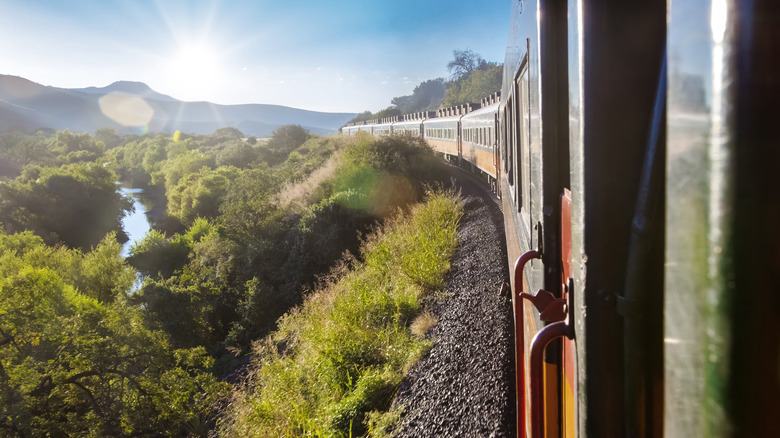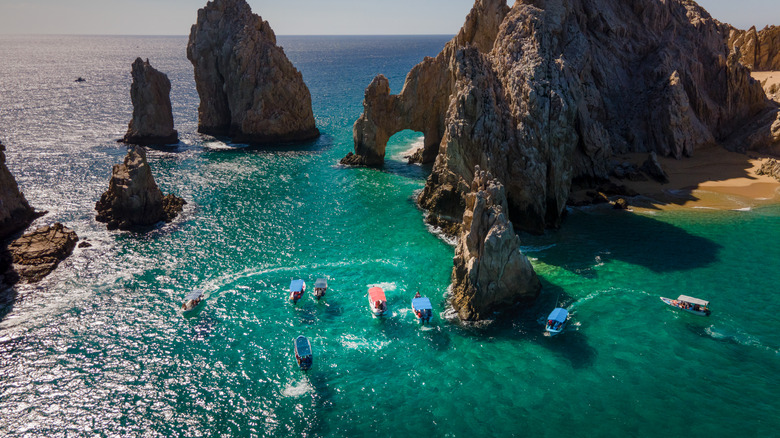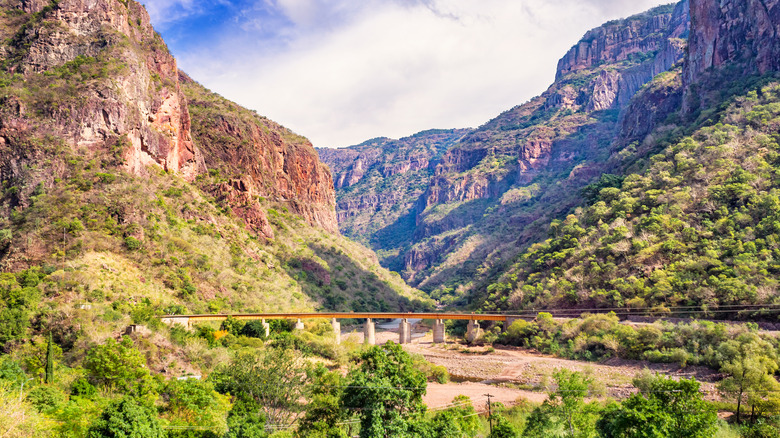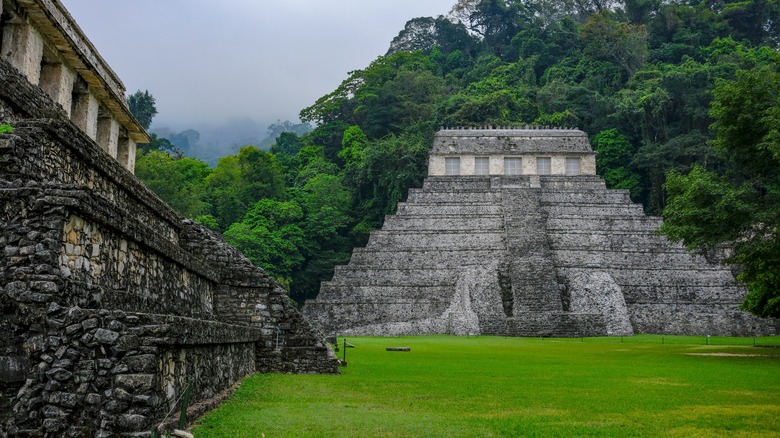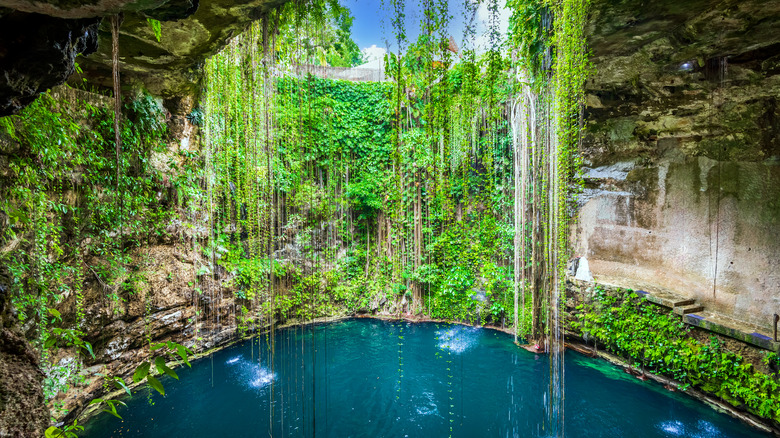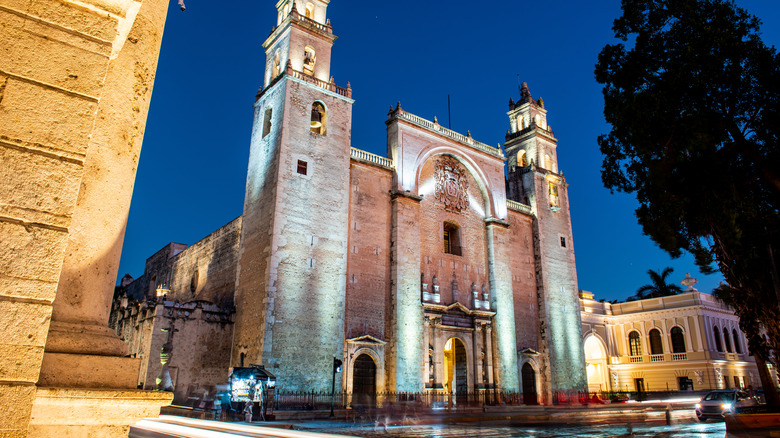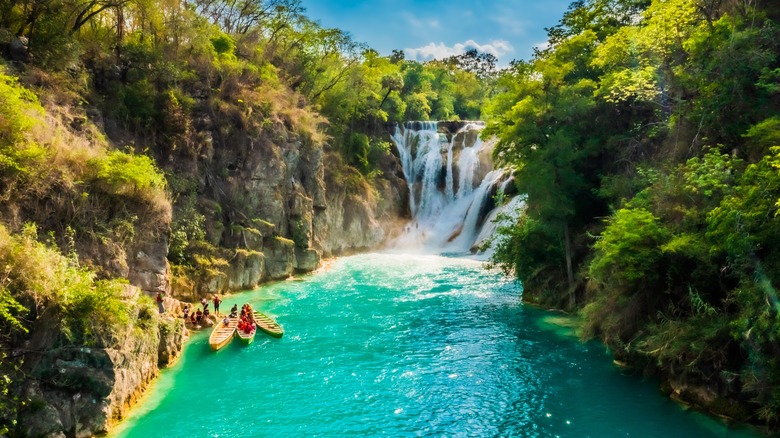Mexico's Top 10 Attractions And Destinations For Adventurous Tourists
Mexico is a large and incredibly beautiful, diverse, and historic country. The North American nation is composed of 32 administrative states, all of which feature distinctive landscapes, heritage, cuisine, and cultural traditions. These are often combined into five to nine broader regions defined by geography, history, and cultural influences — like Baja, the Yucatán Peninsula, Northern Mexico, the Pacific Coast, Central Mexico, and others. One state also comprises the country's capital, Mexico City, considered one of the safest cities to visit as a solo female traveler. The beating heart of the country, it's a metropolitan area home to nearly 23 million people — the seventh largest city in the world just behind São Paolo and Cairo.
Like many of Mexico's thriving colonial cities, Mexico City boasts a beautiful, walkable, and historic city center that's perfect for architecture-lovers, foodies, and photographers. Visitors will also find beach options galore — from Cancún to Puerto Vallarta, and Playa del Carmen — plus hubs for nightlife like Cabo San Lucas. And destinations like Chichén Itzá and Palenque glimpse the incredible former centers of indigenous Maya and Aztec societies.
Different states in Mexico are often ascribed a range of travel advisories from the U.S. State Department based on data suggesting the likelihood of crime or civil unrest. Particularly if driving in some areas, exercise caution and heed safety warnings and tips tourists should know before traveling to Mexico. Many areas remain safe, though, including popular tourist-friendly destinations and spots for travelers seeking unique experiences. All in all, Mexico features an incredible range of options for getting outdoors, viewing wildlife, delving into history, and experiencing the country's fantastic cultural diversity, arts and crafts, and culinary traditions. Below, find 10 destinations perfect to help plan your next trip.
Cabo San Lucas
Located at the southernmost tip of the Baja Peninsula, Cabo San Lucas is a haven for beachgoers, golfers, and anyone seeking fun in the sun. Often referred to simply as Cabo, this destination is eminently popular for those who love to relax on the sand — where you can wander around the energetic marina — or check out popular, pristine beaches like Playa el Medano and Playa Pública Cabo San Lucas.
However, if you're looking to escape town, take in the views, and experience a unique hike while you're at it, head toward Mt. Solmar, situated on the peninsula just south of the marina. The peak sits on private property, belonging to a local business owner named Enrique who runs a business called Dog Training Camp. Enrique leads a daily guided tour up to the summit of the picturesque peak at 8 a.m. every day except Saturday. Arguably the best part: you'll be accompanied by a group of dogs!
If looking at the water makes you want to go out and explore it some more, you can also hop aboard luxury sailing cruises from Cabo San Lucas, most of which include snorkeling opportunities, or explore the area around El Arco (Cabo Arch) and Pelican Rock via a glass-bottomed boat. This region is also fantastic for whale-watching, with a range of small-group boat cruises departing often between December and April, when gray whales migrate from the far north to spend winter in Baja's warmer waters. You'll have the opportunity to spot numerous migrating species — from humpback whales to orcas and dolphins. If you have a car, don't miss a scenic drive up to the artsy enclave of Todos Santos, just an hour north along the west coast.
Copper Canyon
In the state of Chihuahua, in northwestern Mexico, a geological phenomenon sometimes referred to as "Mexico's Grand Canyon" is a sensational canyon that's four times the size of Arizona's. Stunning Copper Canyon actually comprises six separate gorges in the Sierra Madre Occidental Mountains, which extend more than a mile deep in some areas. The name of this destination comes from its greenish-copper hue, and the region is also home to a very remote society of indigenous Tarahumara, or Rarámuri, people, who have gained widespread recognition for their unique ability to run exceedingly long distances.
One of the most attractive facets of a visit to Copper Canyon is its railroad, which connects the cities of Chihuahua and Los Mochis. Because there are no paved roads through the canyon, making it difficult to traverse by car, a train journey is the way to go. The canyon's famous tourist rail route is known as the Chepe Express, or El Chepe, and connects Los Mochis to the communities of El Fuerte, Bahuichivo, Divisadero, and Creel. The route runs northbound on Mondays, Thursdays, and Saturdays, and returns southbound on Tuesdays, Fridays, and Sundays. The journey takes a little less than 10 hours total, but disembarking to explore the towns along the way is where the real fun begins.
Bahuichivo, and nearby Cerocahui, are surrounded by gorgeous peaks and vineyards, while Divisadero is a must-stop for some of the best panoramic views of three of the area's canyons. There, you can also head to Copper Canyon Adventure Park for a ride on a cable car line that's nearly 2.5 miles long, plus to explore numerous multi-use trails that make the most of the vistas.
Historic Mexico City
Established in 1325 — known then as Tenochtitlan, when the Aztecs founded it — the origins of Mexico City make it the oldest city in North America. By the time Spanish conquistadors arrived in 1521, the city was a thriving metropolis home to at least 200,000 people, but their arrival would change everything. Tenochtitlan was besieged and its Aztec buildings destroyed, the lake it sat on was drained, and the newly named Mexico City became the capital of what was then New Spain. Today, many of the buildings we see are remnants of the Spanish colonial period, which lasted until 1821, and were constructed using the same stones that once made up earlier Aztec structures.
Mexico City's historic old town is a remarkably rich destination humming with energy and chock full of gorgeous architecture, as well as great places to eat and stay. Wander around the Centro Histórico to see the stunning Palacio de Bellas Artes, where Art Nouveau and Art Deco styles converge in the nation's most prominent art museum. Plaza de la Constitución is one of the city's most iconic public squares, watched over by the incredible Metropolitan Cathedral, the National Museum of World Cultures, and government buildings like the National Palace and the Supreme Court.
For a must-see detour for art lovers, don't miss a visit to the Frida Kahlo Museum. Also known as Casa Azul, it's where the iconic artist lived and worked for most of her life, eventually joined by her husband and renowned artist in his own right, Diego Rivera. It's located in Coyoacán, which is about 45 minutes south by car from the historic city center, or a 15 to 20-minute walk from either the Line 3 metro stop at Coyoacán, or the Line 2 stop at General Anaya station.
Chichén Itzá
For visitors to Cancún, Mérida, or other parts of the beautiful and tropical Yucatán Peninsula, the ancient Maya metropolis of Chichén Itzá is a popular choice for a day trip, and a must-visit for history buffs traveling to Mexico. The sprawling former city is about 2.5 hours inland by car from Cancún, and numerous day-long tours offer round-trip transportation to see the ruins and, in some cases, visit the peninsula's famous cenotes.
Possibly as early as 415 A.D., the Maya began to settle in the area, eventually establishing a thriving city that, at its height, may have been home to as many as 35,000 residents. Archaeologists believe that its founders, known as the Itza, or "water sorcerers," may have been drawn to the area by its unique geological formations, comprising collapsed caves filled with glittering pools of water. Over several centuries, Chichén Itzá emerged as a major pilgrimage site, and its giant stone pyramid structures are still a major draw today for researchers and tourists alike.
The most recognizable ancient sites include the Great Ball Court, the Temple of the Warriors, and the Temple of Kukulkán, or El Castillo. The latter rises 79 feet high with a giant staircase, and it's oriented to align with annual astronomical events, such as the equinoxes. General admission for adults, as of this writing, is $648 MXN (about $35). To experience an evening event known as Kukulkán Nights, which bathes El Castillo in light projections and sound, admission is $755 MXN (roughly $41).
Guanajuato
Of the 36 places designated as UNESCO World Heritage sites in Mexico, the historic center of Guanajuato is among those that are wonderfully walkable. Its maze-like, narrow, cobbled streets are lined with colorful buildings, churches, and museums and open onto numerous charming plazas. Visit the city's energetic main square — a triangle, actually — called Jardín de la Unión for beautifully pruned shade trees, cafes, bars, and snack vendors. It's also home to the ornate San Diego Church, or Templo de San Diego, built in 1663. Conceived in the extremely elaborate Mexican Churrigueresque style, the hand-carved, locally-quarried pink stone details take Baroque style to the next level. Speaking of Baroque, two other particularly spectacular churches to check out include La Compañía and La Valenciana.
What makes Guanajuato's streets so pedestrian-friendly? Take a peek — or a unique walk — underground! The city's elaborate network of subterranean tunnels were constructed in the 1800s to keep water from the Rio Guanajuato from flooding downtown. After dams were built and the tunnels were no longer needed for water diversion, the city came up with the brilliant idea of routing some of its vehicular traffic through them instead. Today, roughly half the city's traffic is directed underground. Fortunately, pedestrians are also welcome to explore the network's 27 different tunnels.
Palenque, Chiapas
Yet another UNESCO World Heritage site that's a must for history and archaeology enthusiasts, Palenque is a marvel of creativity and civil engineering. Located in the state of Chiapas, this ancient city isn't quite as easy to reach as other major sites like Chichén Itzá, Tulum on the Riviera Maya, or Teotihuacán north of Mexico City. But that's one of the reasons it's extra rewarding to visit. It's possible to drive — just remember to heed current travel advisories — or take an ADO bus from cities east of Mexico City. There are also flights from Mexico City to Villahermosa, from which the community of Palenque is only about a two-hour drive.
Nestled in the jungle, the Palenque archaeological site boasts more than 1,400 buildings, only a tenth of which have so far been explored by archaeologists. It's one of the largest undertakings of its kind, established more than 2,000 years ago, around 100 B.C., then flourishing as a prominent city by around 500 A.D. For a guided experience, join a tour — just make sure to check whether entrance fees to both the ruins and the national park are included. If you arrive independently, tour guides often wait outside of the entrance to offer guided visits in Spanish or English. These may vary in price and might guide you through different areas of the archaeological park.
Cenotes on the Yucatán Peninsula
One of the Yucatán Peninsula's most unique attractions comprises a geologic network that's technically underground. Cenotes, natural pools of water formed in sinkholes, provide a phenomenal way to experience something that makes this part of Mexico special. Plus, they're also a great way to escape the heat. There are upwards of 7,000 cenotes around the Yucatán — and for ancient inhabitants of the area, they were seen as sacred places that supplied precious water. Today, these naturally occurring phenomena are just as enchanting and mysterious.
Fewer than 150 cenotes are available to visit. Stairwells and walkways meander into the subterranean oases so you can see the turquoise waters up close, or even take a dip. The most well-known is called Ik Kil, located close to Chichén Itzá, with water nearly 100 feet deep. Other favorites include Suytun, Samula, Maya, Oxman, and Xkeken — the latter of which is known for its dramatic stalactites. A guided tour is a great way to visit the most popular cenotes, some of which include a stop at Chichén Itzá. Remember to bring your bathing suit to get the full experience.
Mérida
Founded in 1542, Mérida is a Spanish colonial gem of a city that remains the cultural capital of the Yucatán Peninsula. It makes a great jumping-off point for exploring the peninsula's many attractions — from Maya sites like Chichén Itzá and Tulum to Yucatán's beloved cenotes. If your holiday takes you to one of the prestigious luxury resorts along Mexico's Riviera Maya, Mérida is also a popular day trip or overnight choice to experience culinary delights, charming public squares, and phenomenal architecture.
Among the most popular attractions is the Palacio Cantón, a luxurious mansion built in the early 20th century by a Yucatecan general and politician. By comparison, starkly unadorned Catedral de San Ildefonso is made with stones repurposed from a former Maya temple that stood on the site previously. To learn more about the ancient civilization, head to El Gran Museo del Mundo Maya, where you can explore incredible artifacts and experience how this indigenous lineage is still very much a part of local culture today. Once you've had your fill, head to Parque de Santa Lucia for a bit of shade to escape the heat, and make sure to grab a drink or a bite to eat at one of its restaurants. Every Thursday night at 9 p.m., the Yucatecan Serenade enlivens the park with music and dance. Just make sure to arrive an hour or two early if you want a chance for a seat, or reserve in advance.
Oaxaca
Oaxaca, a city that sits in a state of the same name, is a fascinating fusion of indigenous and Spanish colonial influences. The historic center is a UNESCO World Heritage Site, along with the nearby Archaeological Site of Monte Albán, which is yet another remarkable ancient site demonstrating the ingenuity of historic peoples in Mexico. Nestled in the mountains, Oaxaca is also known as a haven for foodies, with excellent and diverse dishes ranging from tlayudas — sometimes described as a "Mexican pizza," as it's made by topping a large corn tortilla with meat and vegetables — to an array of amazing regional mole recipes. Food tours are a great way to experience these culinary traditions, including visits to the local markets.
For a day trip, head to the Hierve el Agua, a collection of natural mineral pools that sit high in the mountains about 40 miles east of the city. The rock formations look like waterfalls, created when mineralized water used to flow down the hillside. Today, the pools at the top of the ledge offer a unique way to take in the view and cool off at the same time. Hierve el Agua can get crowded, though, so arriving early in the day may lend itself to a more relaxing escape.
La Huasteca Potosina, San Luis Potosí
Around 250 miles northwest of Mexico City, nestled at the base of mountains in the central part of the country, you'll find the Spanish colonial city of San Luis Potosí. Less crowded than some of the coastal areas popular with tourists, the city — along with a number of other historic municipalities in the region — makes for a great basecamp for exploring a nearby natural wonder: La Huasteca Potosina.
Named for the indigenous Huastec people, the region is abundantly tropical, full of canyons, and filled with turquoise lakes and streams. It's famous for its aquamarine-tinted tumbling cascades, like Tamul, which make this jungle paradise one of Mexico's best hidden gems. Perfect for outdoors-lovers and adventure-seekers, the area features numerous waterfalls and rivers with energetic rapids for exciting swimming, cliff-jumping, rafting, and more.
Guided tours offer an easy, no-fuss way to see the region's beautiful landscapes, but you can also rent a car in San Luis Potosí to explore the area at your own pace. Head to Media Luna Lagoon for a unique diving experience up to 100 feet below the surface, or wander along Puente de Dios, or "God's Bridge," located east of Rioverde, to hike around a natural land bridge and swim in a rushing river.
Methodology
While there are myriad places to visit and things to do across the length and breadth of Mexico, we focused on 10 great options for travelers who seek a bit of adventure — even in some of the areas usually associated with all-inclusive resorts and relaxing on the beach. We researched destinations on sites like True.travel, Travels-Mexico.com, Yucatan.travel, OaxacaTravelTips.com, and Mexperience.com, and we consulted attractions' official sites like VisitCopperCanyon.com, ChichenItza.com, and MexicoCity.CDMX.gob.mx to compile specific information and data, like entry times and historical context.
We also researched additional context about regions and sites using Britannica.com, UNESCO, Thrillist.com, HistoryHit.com, and LonelyPlanet.com. In some cases, we also relied on the author's personal experiences, and we made sure to share the most-loved sites and experiences, thanks to visitors who left reviews and ratings on TripAdvisor, Get Your Guide, and Google.
